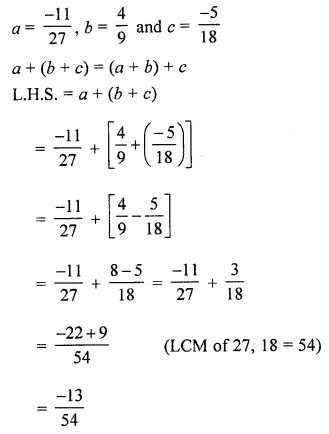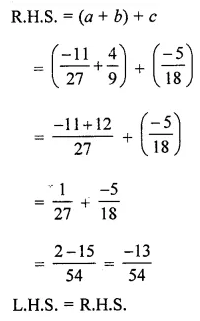Selina Publishers Concise Chemistry Class 8 ICSE Solutions Chapter 6 Chemical Reactions
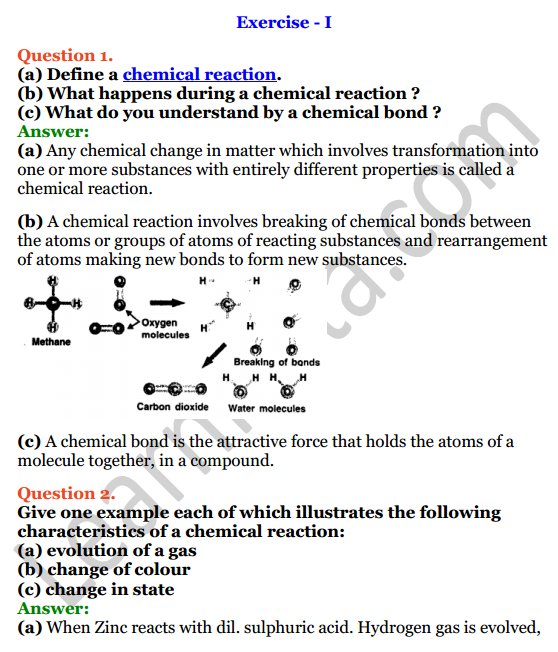
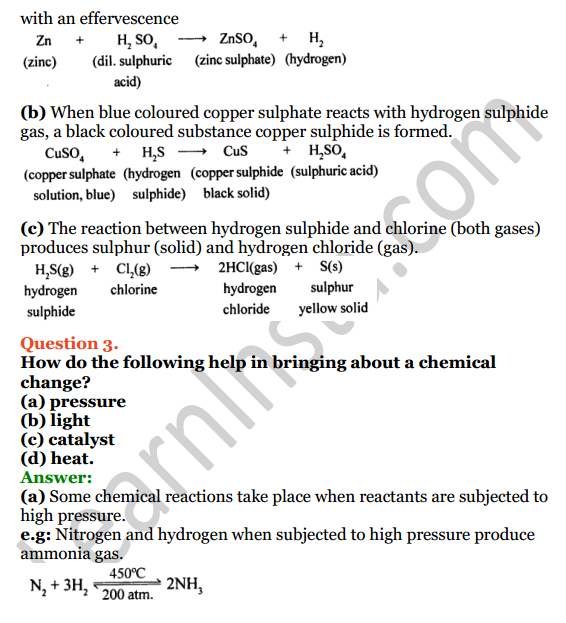
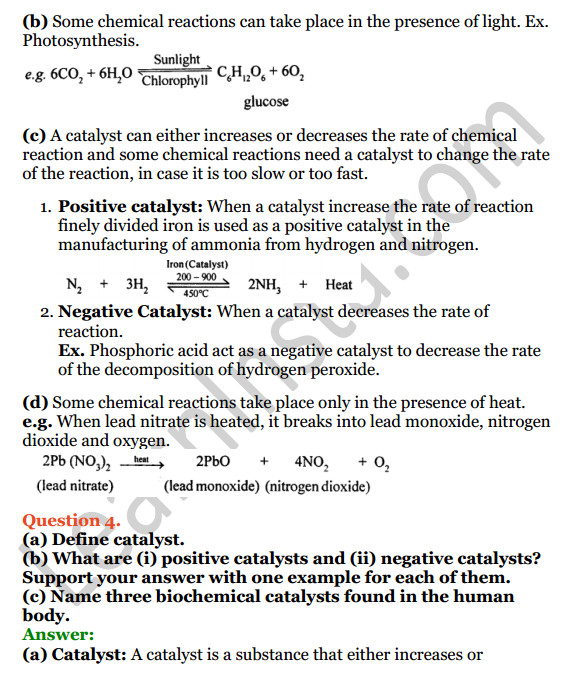
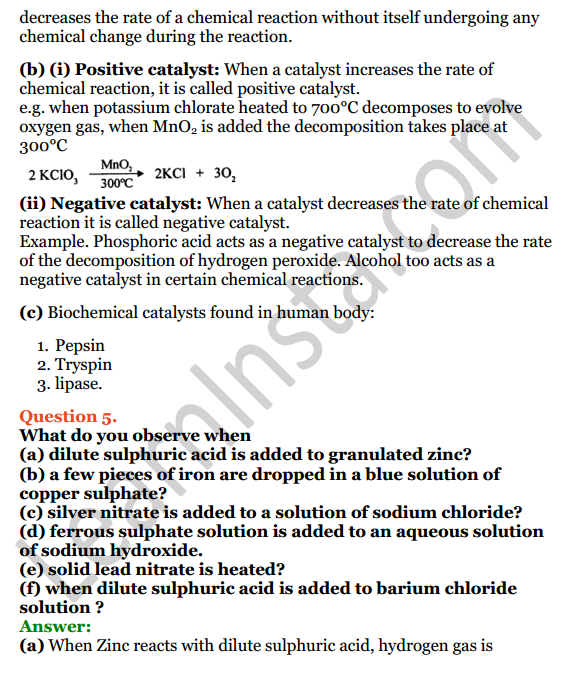
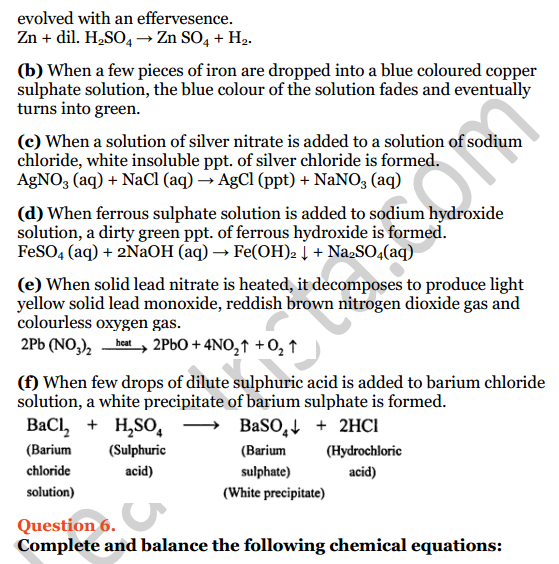
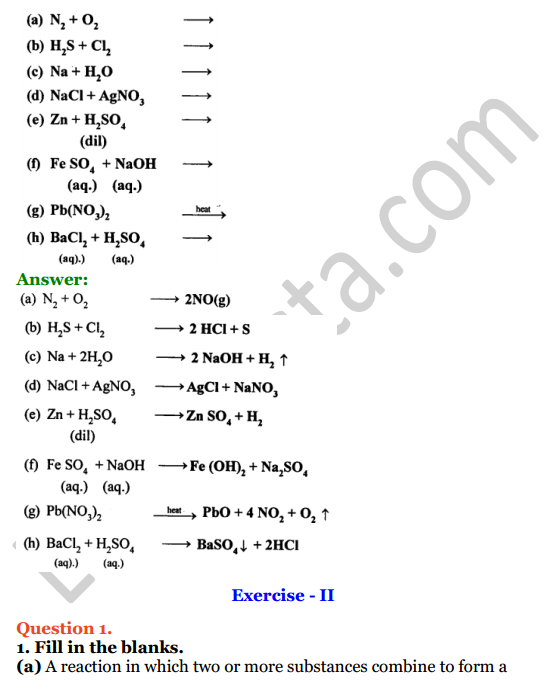

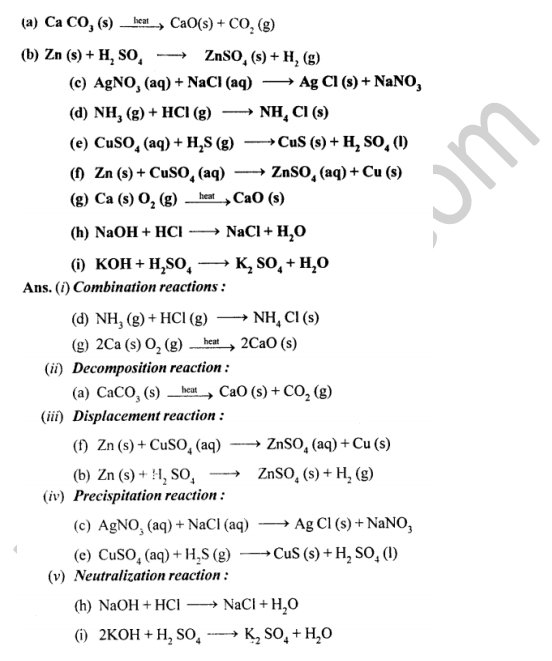
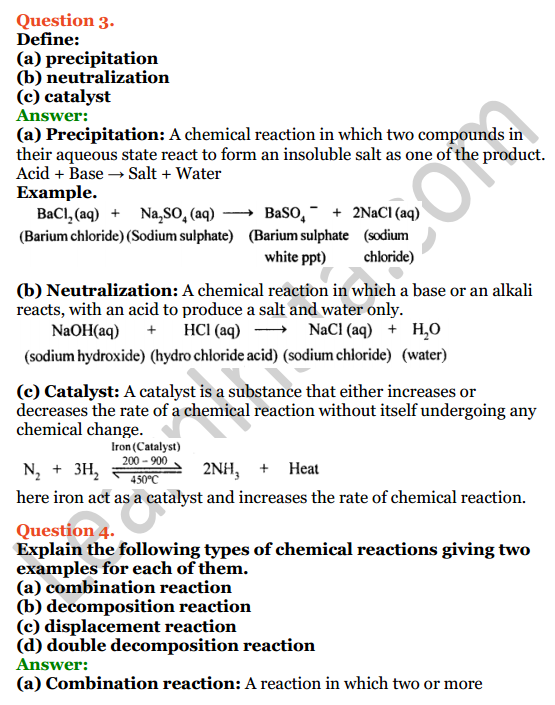
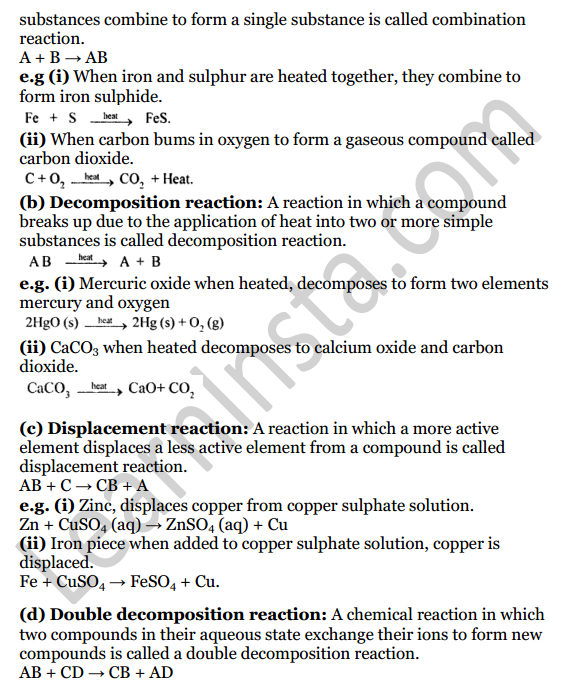
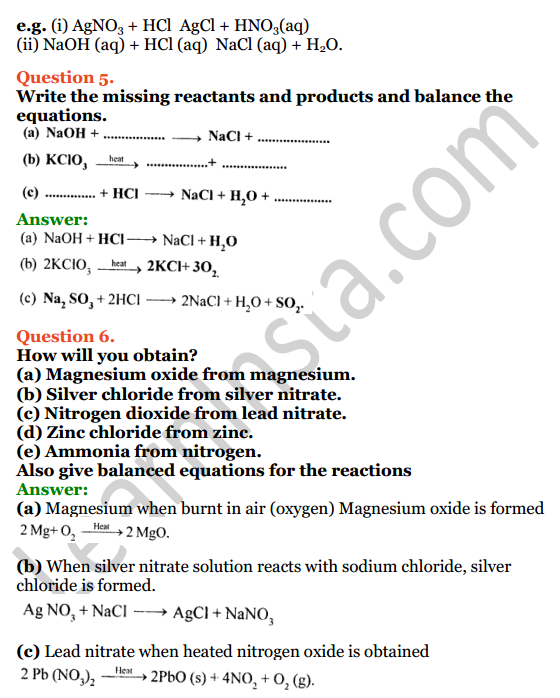
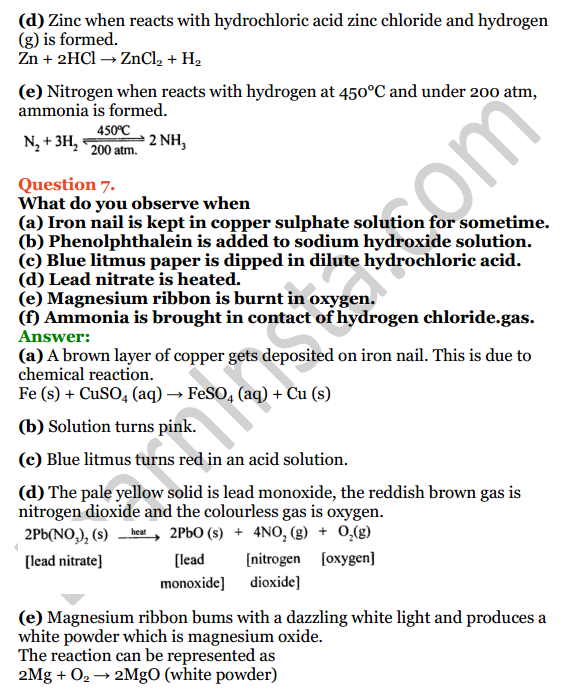
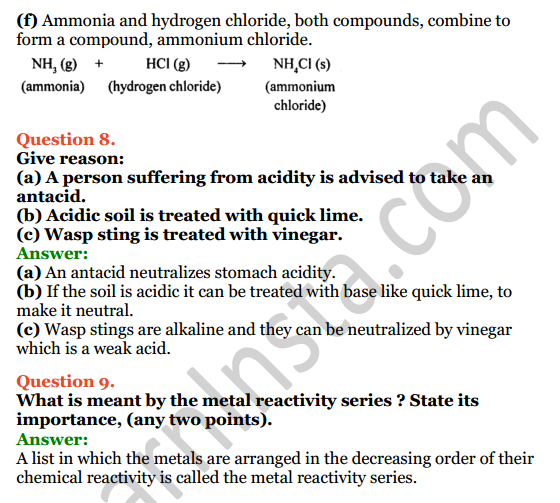
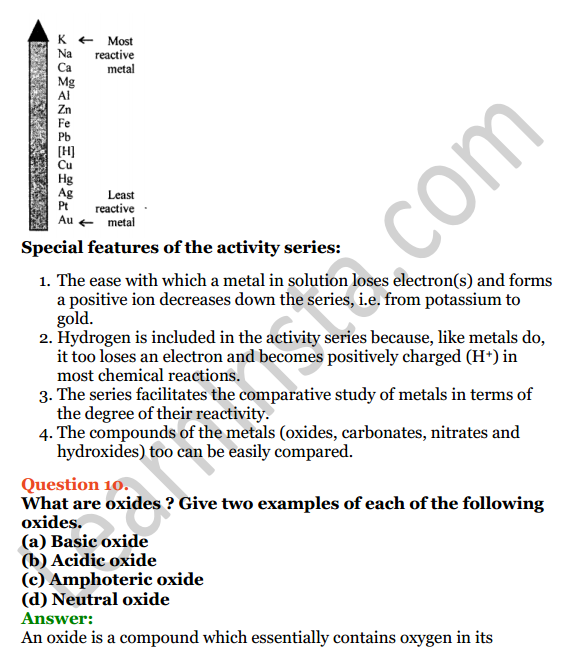
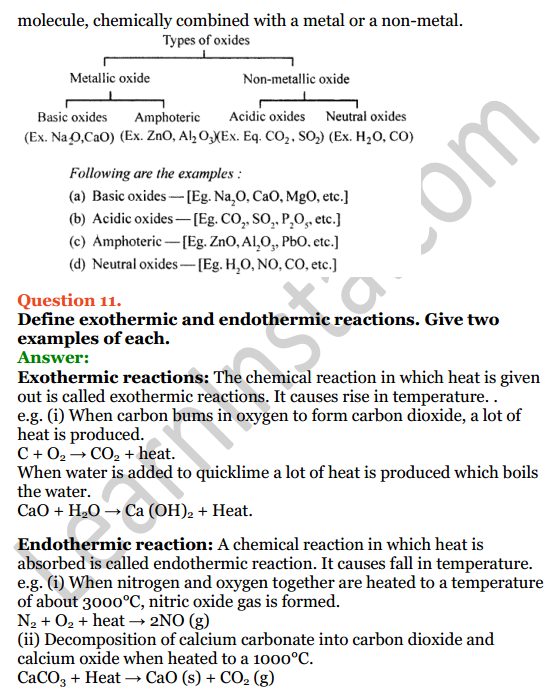
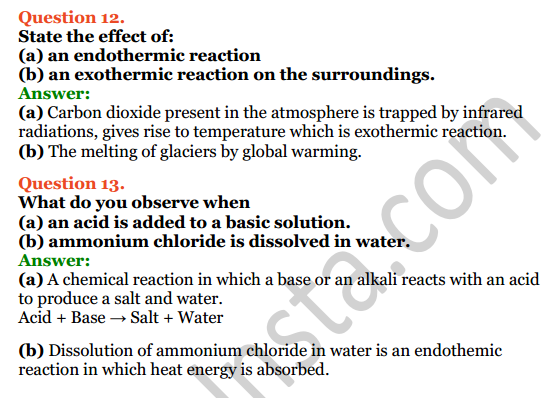
















Question 1.
Evaluate the following:

Solution:

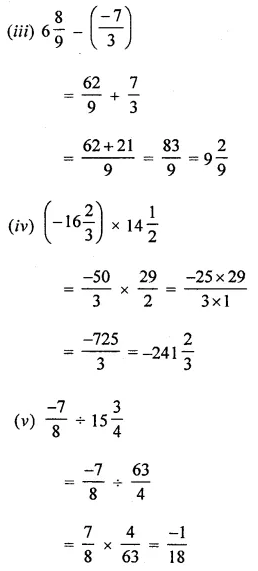
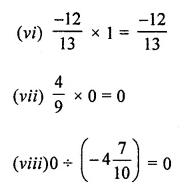
Question 2.
What number should be added to \(\frac { -4 }{ 11 }\) to get \(\frac { -3 }{ 8 }\)?
Solution:

Question 3.
What rational number should be subtracted from the sum of \(\frac { 3 }{ 14 }\) and \(\frac { -4 }{ 7 }\) to get \(\frac { 13 }{ 21 }\)?
Solution:
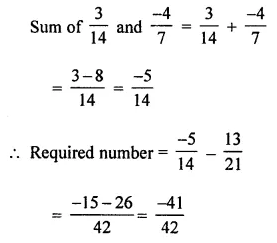
Question 4.
If the product of two rational numbers is \(\frac { 25 }{ 42 }\) and one of them -2\(\frac { 6 }{ 7 }\), find the other.
Solution:

Question 5.
Divide the sum of \(\frac { 4 }{ 13 }\) and \(\frac { -3 }{ 2 }\) by their product.
Solution:
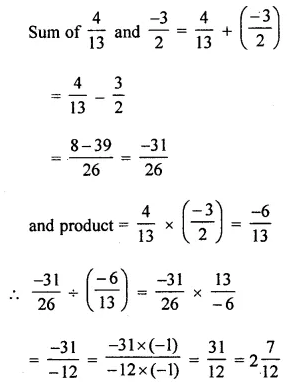
Question 6.
Using the appropriate properties of operations of rational numbers, evaluate the following:
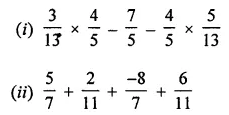
Solution:
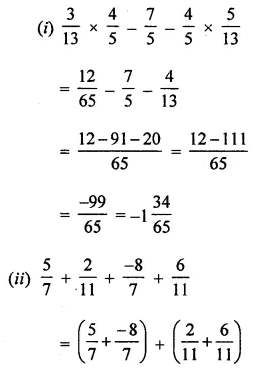
Question 7.
Find the additive inverse of the following:
(i) -13\(\frac { 7 }{ 8 }\)
(ii) 4\(\frac { 3 }{ 6 }\)
Solution:

Question 8.
Find the multiplicative inverse of the following:
(i) \(\frac { -23 }{ 46 }\)
(ii) 0
Solution:

Question 9.
Represent the following rational numbers on the number line:
(i) \(\frac { -3 }{ 11 }\)
(ii) \(\frac { 5 }{ 17 }\)
Solution:
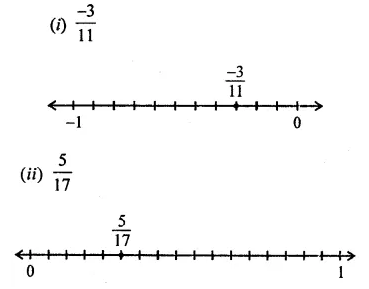
Question 10.
Insert five rational numbers between \(\frac { -3 }{ 7 }\) and \(\frac { 2 }{ 5 }\)
Solution:

Question 11.
If p = \(\frac { -4 }{ 9 }\) , q = \(\frac { 2 }{ 3 }\) and r = \(\frac { -8 }{ 11 }\), then verily the foflowing:
(i) p + (q + r) = (p + q) + r
(ii) p × q = q × p
(iii) p × (q + r) = p × q + p × r
(iv) (p + q) ÷ r = p ÷ r + q ÷ r.
Solution:


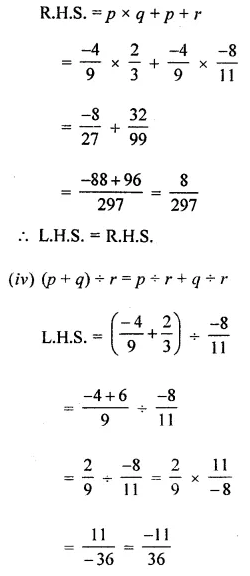
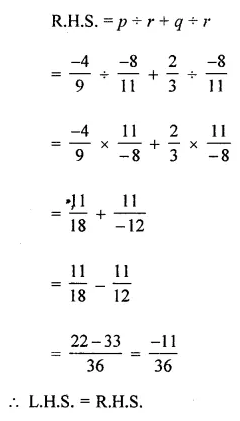
Question 12.
A wedding cake weighed 8 kg. If \(\frac { 2 }{ 5 }\) th of its weight was flour, \(\frac { 5 }{ 16 }\) th was sugar, \(\frac { 1 }{ 4 }\) thwas cream and the rest were nuts, find the weight of nuts.
Solution:
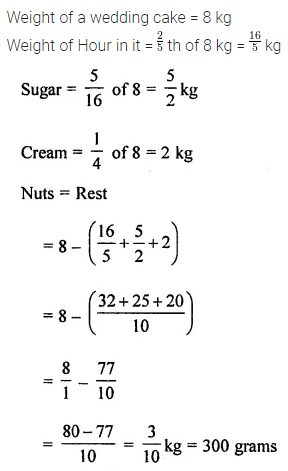
Mental Maths
Question 1.
Fill in the blanks:
(i) The product of two rational numbers is a ……….
(ii) Subtraction of rational numbers is …….. commutative.
(iii) The rational number \(\frac { -7 }{ 4 }\) lies ……. of zero on the number line.
(iv) Division of rational numbers is ……… associative.
(v) \(\frac { p }{ q }\) ÷ 0 is ……..
(vi) Negative of a rational number is called its ………
(vii) Multiplicative identity of rational numbers is ……….
(viii) Multiplication of rational numbers is ……. over addition.
(ix) Division of a rational number by a non-zero rational number is a ………..
(x) The rational number which is additive inverse of itself is …………
Solution:
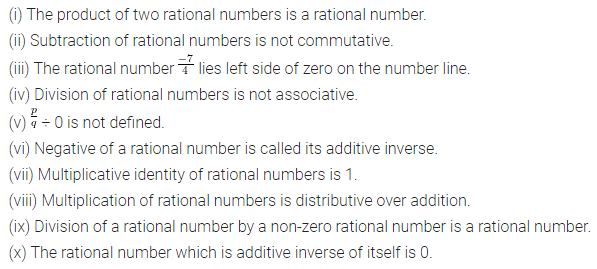
Question 2.
State whether the following statements are true (T) or false (F):
(i) \(\frac { -5 }{ 9 }\) is the additive inverse of \(\frac { 5 }{ 9 }\).
(ii) Every integer is a rational number.
(iii) Zero has its multiplicative inverse.
(iv) Every rational number is an integer.
(v) Division of two rational numbers is alwasy closed.
(vi) Non-terminating, non-recurring decimal numbers are rational numbers.
(vii) 0 is the multiplicative identity of rational numbers.
(viii) Non-terminating recurring decimal numbers are not rational numbers.
(ix) Subtraction of two rational numbers is not associative.
(x) Reciprocal of 1 is 1.
(xi) The multiplicative inverse is also called a reciprocal.
(xii) Between two different rational numbers, there are infinitely many number of rational numbers.
Solution:
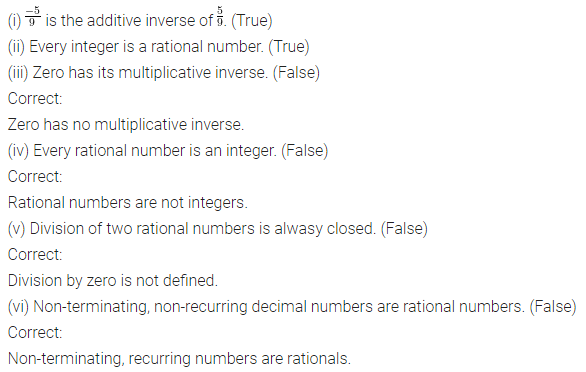
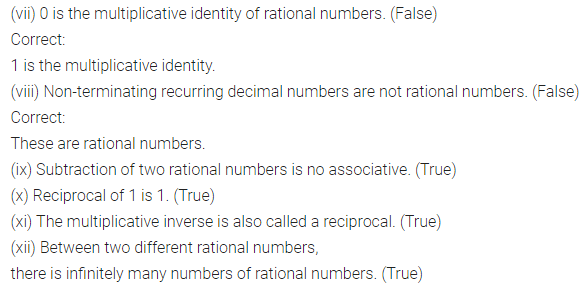
Multiple Choice Questions
Choose the correct answer from the given four options (3 to 18):
Question 3.
Additive inverse of \(\frac { -2 }{ -5 }\) is
(a) \(\frac { 2 }{ 5 }\)
(b) \(\frac { 5 }{ 2 }\)
(c) \(\frac { 2 }{ -5 }\)
(d) \(\frac { 5 }{ -2 }\)
Solution:
![]()
Question 4.
Multiplicative inverse of \(\frac { -3 }{ 7 }\) is
(a) \(\frac { 7 }{ 3 }\)
(b) \(\frac { -7 }{ 3 }\)
(c) \(\frac { 3 }{ 7 }\)
(d) None of these
Solution:
![]()
Question 5.
Sum of a rational number and its additive inverse is
(a) 1
(b) 0
(c) -1
(d) None of these
Solution:
![]()
Question 6.
Rational numbers are not closed under
(a) addition
(b) subtraction
(c) multiplication
(d) division
Solution:
![]()
Question 7.
0 ÷ \(\frac { 2 }{ 3 }\) is equal to
(a) \(\frac { 2 }{ 3 }\)
(b) \(\frac { 3 }{ 2 }\)
(c) 0
(d) not defined
Solution:
![]()
Question 8.
\(\frac { 2 }{ 3 }\) ÷ 0 is equal to
(a) \(\frac { 2 }{ 3 }\)
(b) \(\frac { 3 }{ 2 }\)
(c) 0
(d) not defined
Solution:
![]()
Question 9.
\(\frac { p }{ q } +\left( \frac { r }{ s } +\frac { t }{ u } \right) =\left( \frac { p }{ q } +\frac { r }{ s } \right) +\frac { t }{ u }\) is called
(a) commutative property
(b) associative property
(c) distributive property
(d) None of these
Solution:

Question 10.
Multiplication of a non-zero rational number and its reciprocal is
(a) 0
(b) 1
(c) -1
(d) None of these
Solution:
![]()
Question 11.
Product of rational number \(\frac { -2 }{ 5 }\) and its additive inverse is
(a) 0
(b) 1
(c) \(\frac { -4 }{ 25 }\)
(d) \(\frac { -5 }{ 2 }\)
Solution:
![]()
Question 12.
Sum of rational number \(\frac { 4 }{ 7 }\) and its reciprocal is
(a) \(\frac { 28 }{ 65 }\)
(b) \(\frac { 65 }{ 28 }\)
(c) \(\frac { -28 }{ 65 }\)
(d) \(\frac { -65 }{ 28 }\)
Solution:
![]()
Question 13.
Sum of two rational numbers is 0, if one ofthem is \(\frac { -4 }{ 5 }\), then other is
(a) \(\frac { 5 }{ 4 }\)
(b) \(\frac { 4}{ 5 }\)
(c) \(\frac { -5 }{ 4 }\)
(d) \(\frac { -4 }{ 5 }\)
Solution:

Question 14.
Product of two rational numbers is 1, if one of them is \(\frac { 10 }{ 3 }\), then other is
(a) \(\frac { 3 }{ 10 }\)
(b) \(\frac { -3}{ 10 }\)
(c) \(\frac { 10 }{ 3 }\)
(d) None of these
Solution:

Question 15.
Rational number represented by the point P on the number line is

(a) \(\frac { -5 }{ 7 }\)
(b) \(\frac { -3}{ 7 }\)
(c) \(\frac { -5 }{ 8 }\)
(d) \(\frac { -4 }{ 8 }\)
Solution:

Question 16.
What should be subtracted from \(\frac { -5 }{ 3 }\) to get \(\frac { -2 }{ 7 }\)?
(a) \(\frac { 29 }{ 21 }\)
(b) \(\frac { -21}{ 29 }\)
(c) \(\frac { -29 }{ 21 }\)
(d) \(\frac { 21 }{ 29 }\)
Solution:
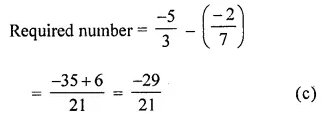
Question 17.
Reciprocal of a negative number is
(a) positive
(b) negative
(c) can not say
(d) does not exist
Solution:
![]()
Question 18.
Which of the following statement is true?
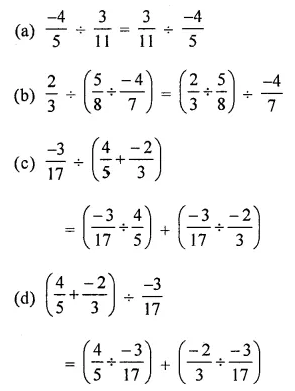
Solution:
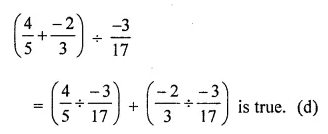
Value Based Questions
Question 1.
Ram donated \(\frac { 1 }{ 10 }\) of his salary to an orphanage, \(\frac { 1 }{ 3 }\) of his salary spent on food, \(\frac { 1 }{ 4 }\) of salary on rent and electricity and \(\frac { 1 }{ 20 }\) of his salary on telephone. This month he donated ₹ 5000 in Prime Minister relief fund for Uttarakhand victims. He was left with ₹ 3000 with him, find his monthly salary. Should we donate the money for needy people? What values are being promoted?
Solution:
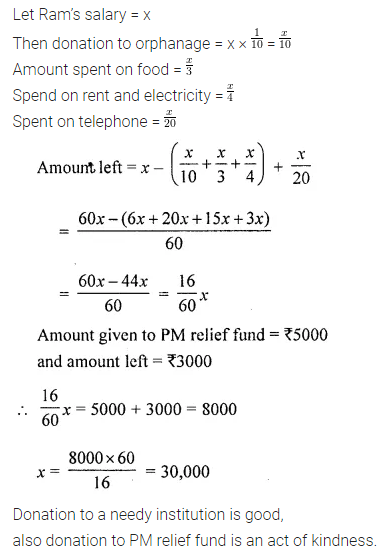
Question 2.
In an Examination \(\frac { 1 }{ 3 }\) of the total students used unfair means and out of which \(\frac { 1 }{ 4 }\) caught red handed while cheating. If 5 students caught red handed then find the total number of students appeared in exam.
Why should we not use unfair means in an examination?
What values are being promoted?
Solution:

Higher Order Thinking Skills (HOTS)
Question 1.
Area ol a square is 4 sq. in more than \(\frac { 2 }{ 3 }\) of the area of a rectangle. If the area of square is 64 sq. m, then find the dimensions of the rectangle, given that breadth is \(\frac { 2 }{ 5 }\) of length.
Solution:
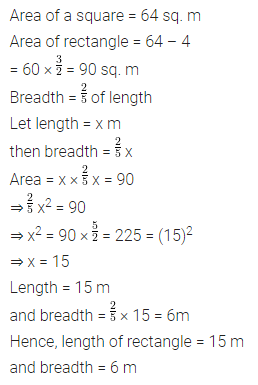
Question 2.
Rahul can do \(\frac { 2 }{ 7 }\) of a certain work in 6 days while Suresh can do \(\frac { 3 }{ 5 }\) of the same work in 9 days. They started work together but after 7 days Rahul left the work. Find in how many days Suresh can complete the remaining work?
Solution:
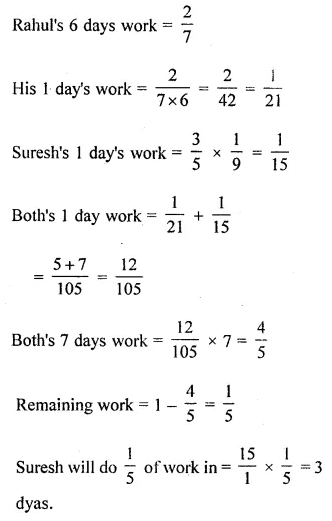
Question 1.
In a bag, there are 20 kg of fruits. If 7\(\frac { 1 }{ 6 }\) kg of these fruits be oranges and 8\(\frac { 2 }{ 3 }\) kg of thee are apples and rest are grapes. Find the mass of the grapes in the bag.
Solution:
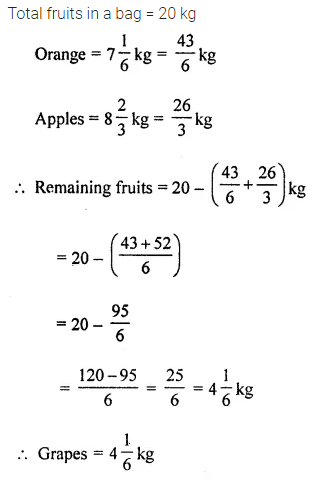
Question 2.
The population of a city is 6,63,432. If \(\frac { 1 }{ 2 }\) of the population are adult males and \(\frac { 1 }{ 3 }\) of the population are adult females, then find the number of children in the city.
Solution:
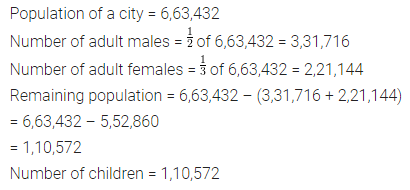
Question 3.
In an election of housing society, there are 30 voters. Each of them gives the vote. Three persons X, Y and Z are standing for the post of Secretary. If Mr X got \(\frac { 2 }{ 5 }\) of the total votes and Mr Z got \(\frac { 1 }{ 3 }\) of the total votes, then find the number of votes which Mr Y got.
Solution:
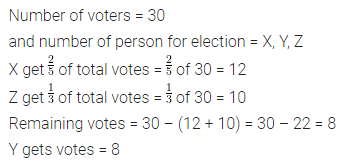
Question 4.
A person earns ₹ 100 in a day. If he spent ₹ 14\(\frac { 2 }{ 7 }\) on food and ₹ 30\(\frac { 2 }{ 3 }\) on petrol. How much did he save on that day?
Solution:
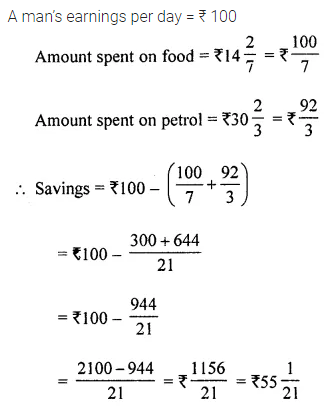
Question 5.
In an examination, 400 students appeared. If \(\frac { 2 }{ 3 }\) of the boys and all 130 girls passed in the examination, then find how many boys failed in an examination?
Solution:
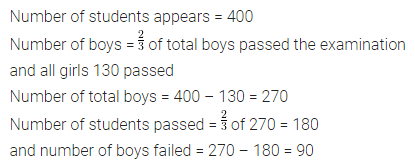
Question 6.
A car is moving at the speed of 40\(\frac { 2 }{ 3 }\) km/h. Find how much distance will it cover in \(\frac { 9 }{ 10 }\) hrs?
Solution:
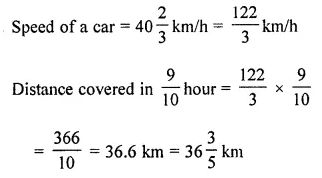
Question 7.
Find the area of a square lawn whose one side is 5\(\frac { 7 }{ 9 }\) m long.
Solution:
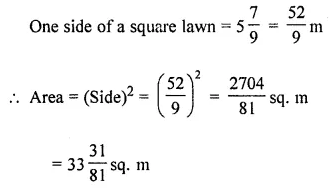
Question 8.
Perimeter of a rectangle is 15\(\frac { 3 }{ 7 }\) m. If the length is 4\(\frac { 2 }{ 7 }\) m, find its breadth.
Solution:
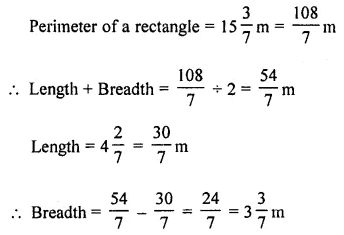
Question 9.
Rahul had a rope of 325\(\frac { 4 }{ 5 }\) m long. He cut off a 150\(\frac { 3 }{ 5 }\) m long piece, then he divided the rest of the rope into 3 parts of equal length. Find the length of each part.
Solution:
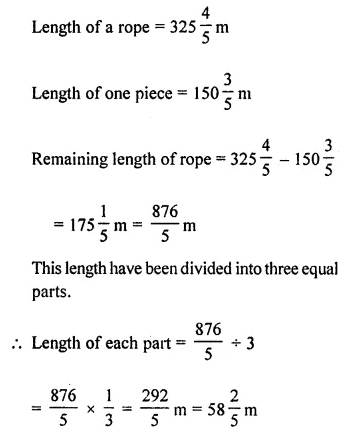
Question 10.
If 3\(\frac { 1 }{ 2 }\) litre of petrol costs ₹ 270\(\frac { 3 }{ 8 }\), then find the cost of 4 litre of petrol.
Solution:
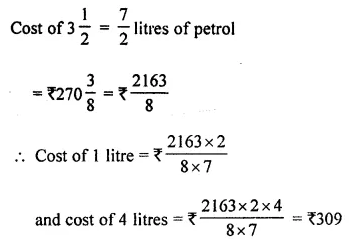
Question 11.
Ramesh earns ₹ 40,000 per month. He spends \(\frac { 3 }{ 8 }\) of the income on food, \(\frac { 1 }{ 5 }\) of the remaining on LIC premium and then \(\frac { 1 }{ 2 }\) of the remaining on other expenses. Find how much money is left with him?
Solution:
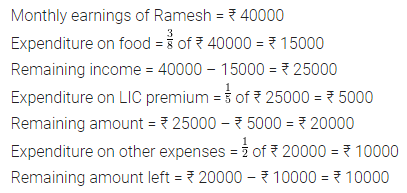
Question 12.
A, B, C, D and E went to a restaurant for dinner. A paid \(\frac { 1 }{ 2 }\) of the bill, B paid \(\frac { 1 }{ 5 }\) of the bill and rest of the bill was shared equally by C, D and E. What fraction of the bill was paid by each?
Solution:

Question 13.
\(\frac { 2 }{ 5 }\) of total number of students of a school come by car while \(\frac { 1 }{ 4 }\) of students come by bus to school. All the other students walk to school of which \(\frac { 1 }{ 3 }\) walk on their own and the rest are escorted by their parents. If 224 students come to school walking on their own, how many students study in the school?
Solution:

Question 14.
A mother and her two sons got a room constructed for ₹ 60,000. The elder son contributes \(\frac { 3 }{ 8 }\) of his mother’s contribution while the younger son contributes \(\frac { 1 }{ 2 }\) of his mother’s share. How much do the three contribute individually?
Solution:
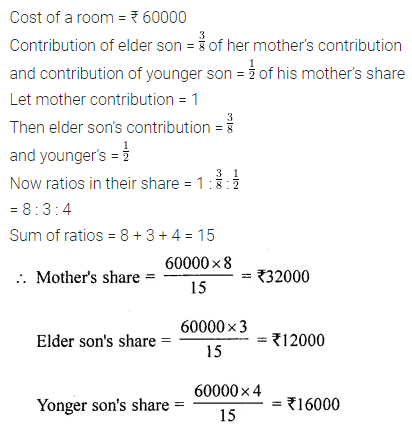
Question 15.
In a class of 56 students, the number of boys is \(\frac { 2 }{ 5 }\) th of the number of girls. Find the number of boys and girls.
Solution:
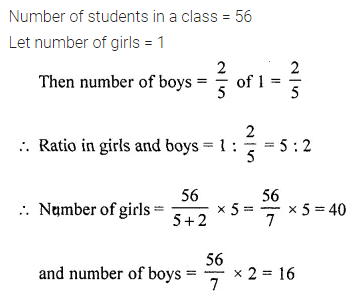
Question 16.
A man donated \(\frac { 1 }{ 10 }\) of his money to a school, \(\frac { 1 }{ 6 }\) th of the remaining to a church and the remaining money he distributed equally among his three children. If each child gets ₹ 50000, how much money did the man originally have?
Solution:
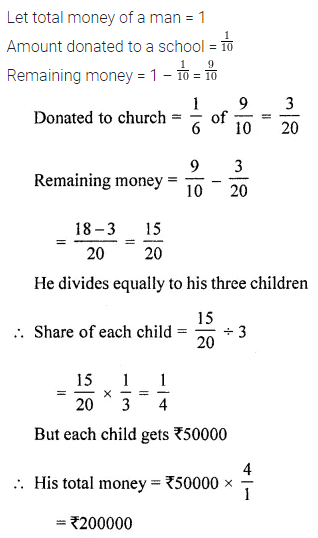
Question 17.
If \(\frac { 1 }{ 4 }\) of a number is added to \(\frac { 1 }{ 3 }\) of that number, the result is 15 greater than half of that number. Find the number.
Solution:
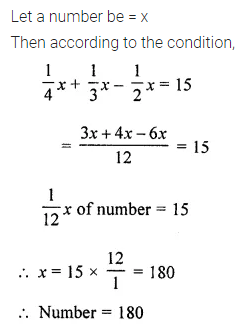
Question 18.
A student was asked to multiply a given number by \(\frac { 4 }{ 5 }\). By mistake, he divided the given number by \(\frac { 4 }{ 5 }\). His answer was 36 more than the correct answer. What was the given number?
Solution:
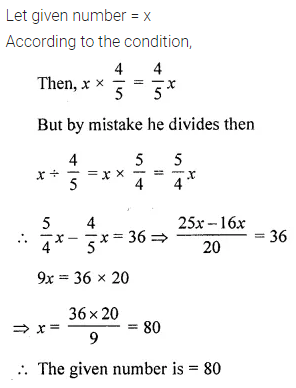
Question 1.
Represent the following rational numbers on the number line:
(i) \(\frac { 11 }{ 4 }\)
(ii) 4\(\frac { 3 }{ 5 }\)
(iii) \(\frac { -9 }{ 7 }\)
(iv) \(\frac { -2 }{ -5 }\)
Solution:
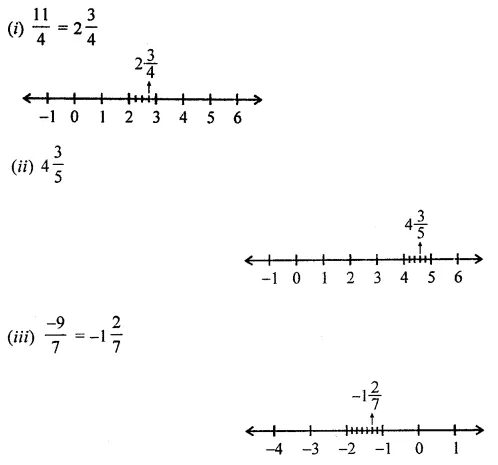
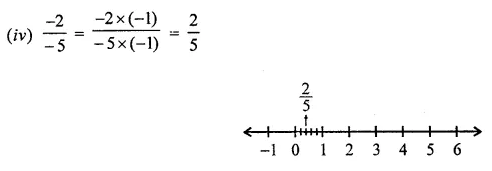
Question 2.
Write the rational numbers for each point labelled with a letter:

Solution:

Question 3.
Find twenty rational numbers between \(\frac { -3 }{ 7 }\) and \(\frac { 2 }{ 3 }\)
Solution:

Question 4.
Find six rational numbers between \(\frac { -1 }{ 2 }\) and \(\frac { 5 }{ 4 }\)
Solution:
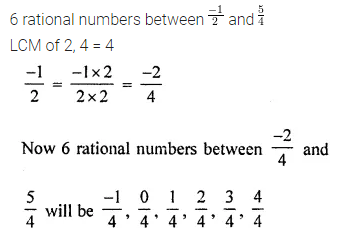
Question 5.
Find three rational numbers between -2 and -1.
Solution:
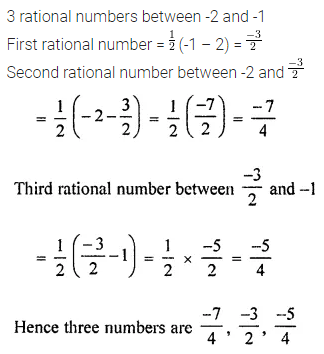
Question 6.
Write ten rational numbers which are greater than 0.
Solution:

Question 7.
Write five rational numbers which are smaller than -4.
Solution:

Question 8.
Identify the rational number which is different from the other three. Explain your reasoning

Solution:

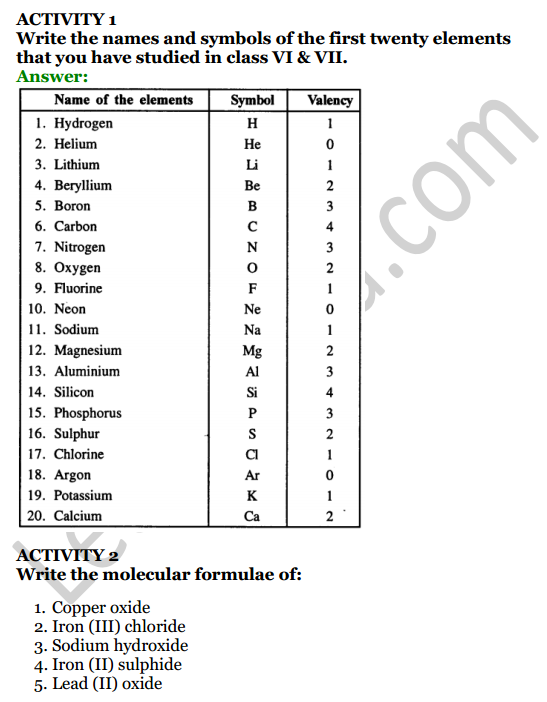
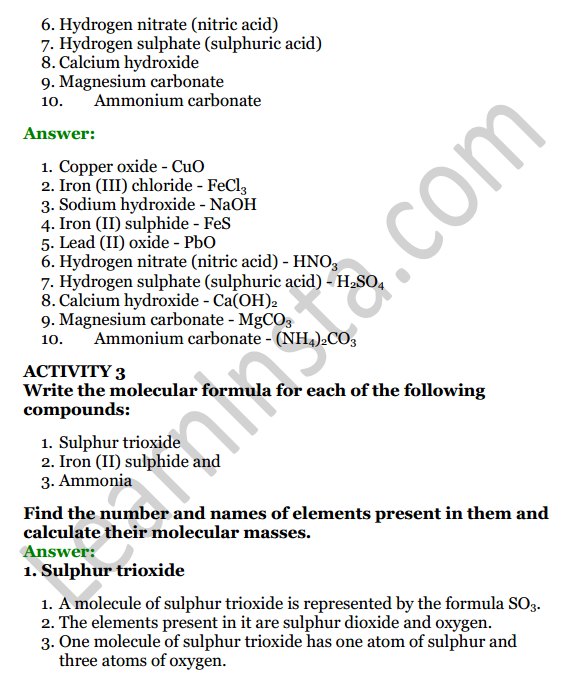
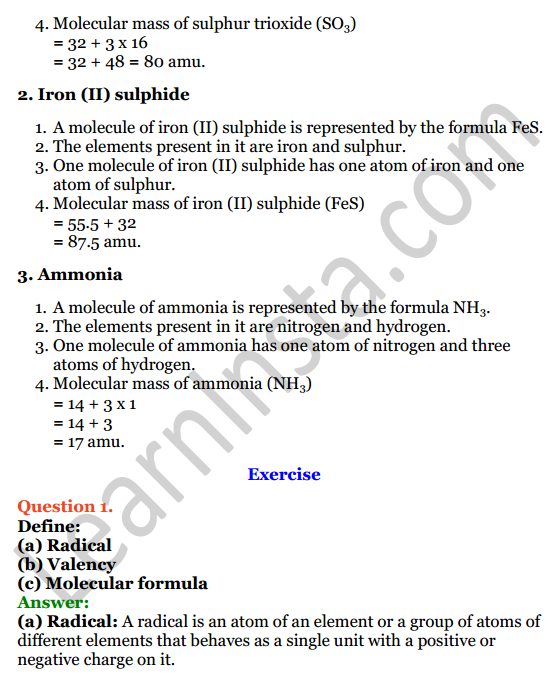
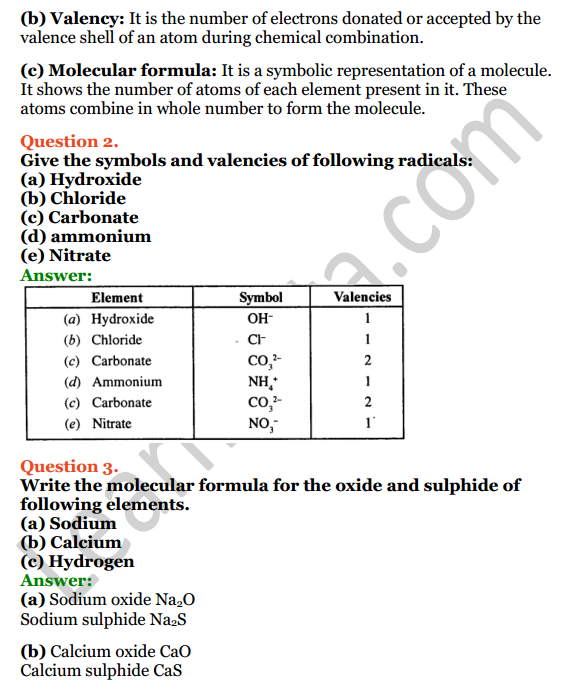
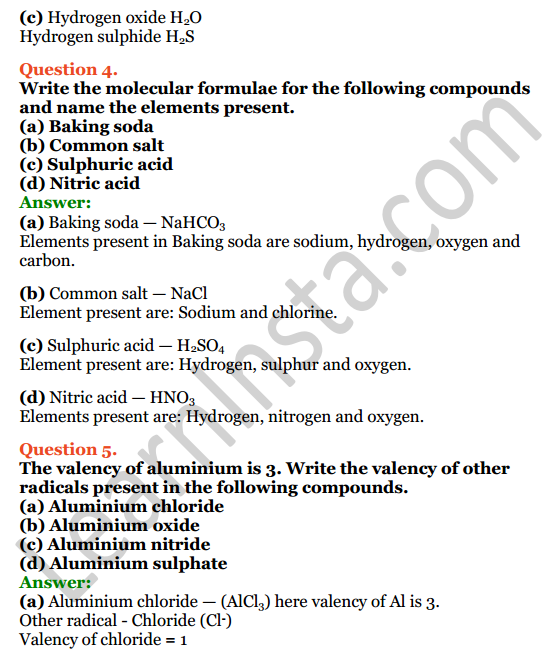
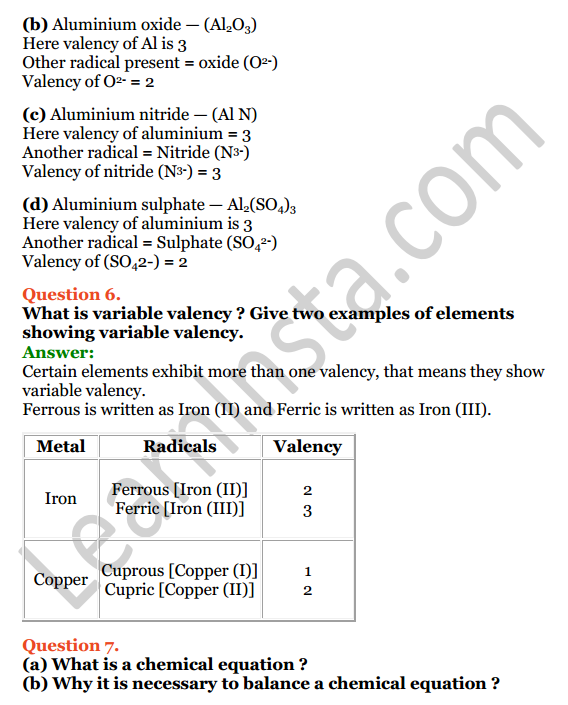

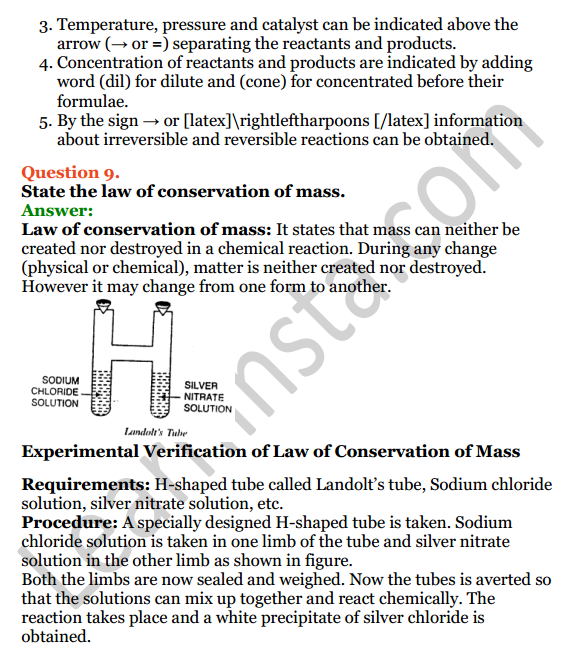
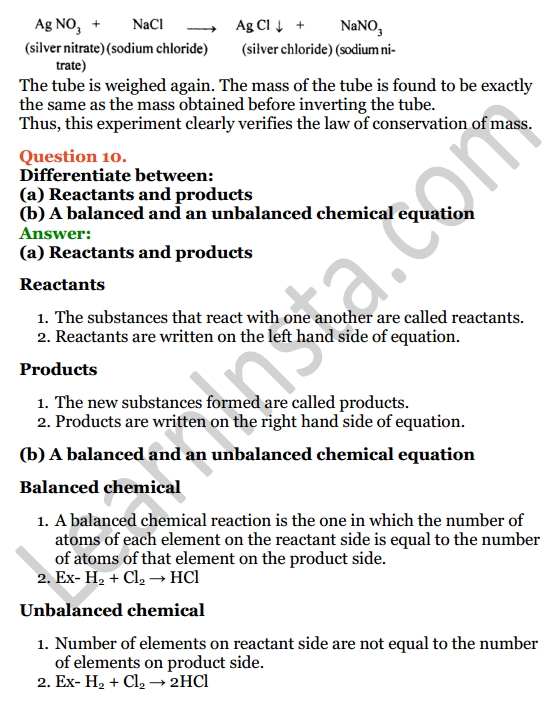
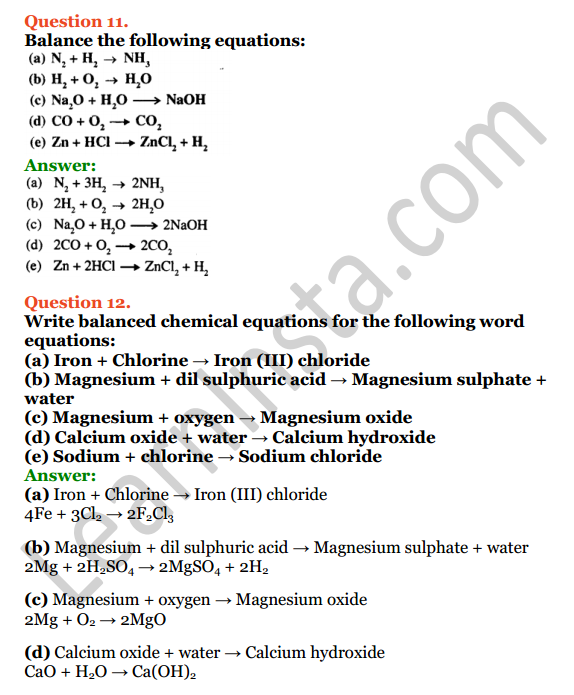
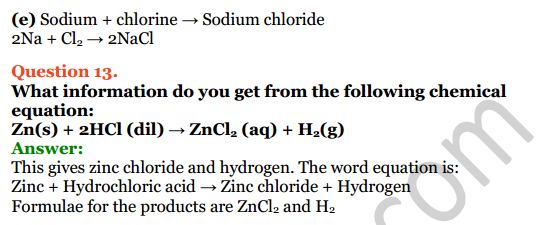
Question 1.
Find the value of the following:

Solution:
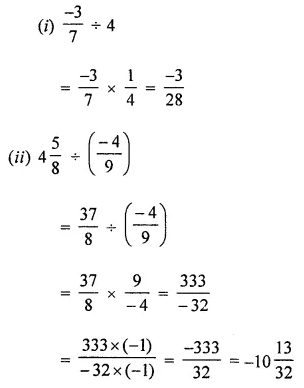
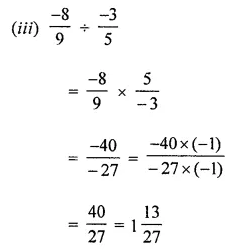
Question 2.
State whether the following statements are true or false:
(i) \(\frac { -9 }{ 13 }\) ÷ \(\frac { 2 }{ 7 }\) is a rational number.
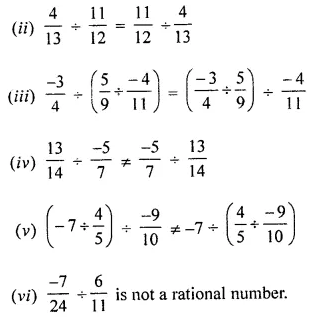
Solution:

Question 3.
The product of two rational numbers is \(\frac { -11 }{ 12 }\). If one of them is 2\(\frac { 4 }{ 9 }\), find the other.
Solution:
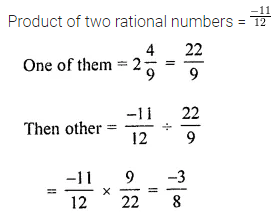
Question 4.
By what rational number should \(\frac { -7 }{ 12 }\) be multiplied to get the product as \(\frac { 5 }{ 14 }\) ?
Solution:
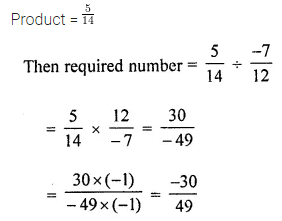
Question 5.
By what rational number should -3 is divided to get \(\frac { -9 }{ 13 }\)?
Solution:
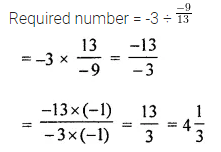
Question 6.
Divide the sum of \(\frac { -13 }{ 8 }\) and \(\frac { 5 }{ 12 }\) by their difference.
Solution:
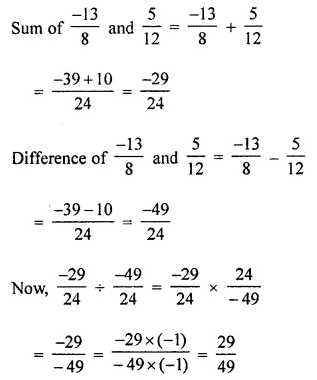
Question 7.
Divide the sum of \(\frac { 8 }{ 3 }\) and \(\frac { 4 }{ 7 }\) by the product of \(\frac { -3 }{ 7 }\) and \(\frac { 14 }{ 9 }\).
Solution:
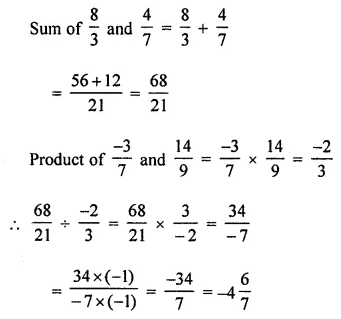
Question 8.
If p = \(\frac { -3 }{ 2 }\), q = \(\frac { 4 }{ 5 }\) and r = \(\frac { -7 }{ 12 }\), then verify that (p ÷ q) ÷ r ≠ p ÷ (q ÷ r).
Solution:
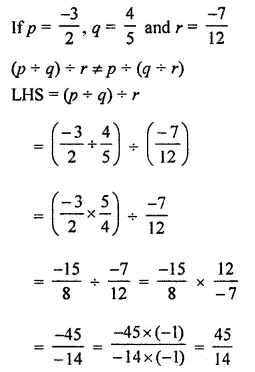
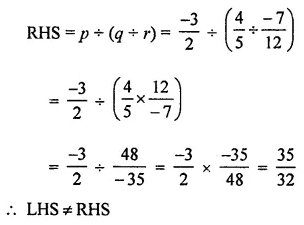

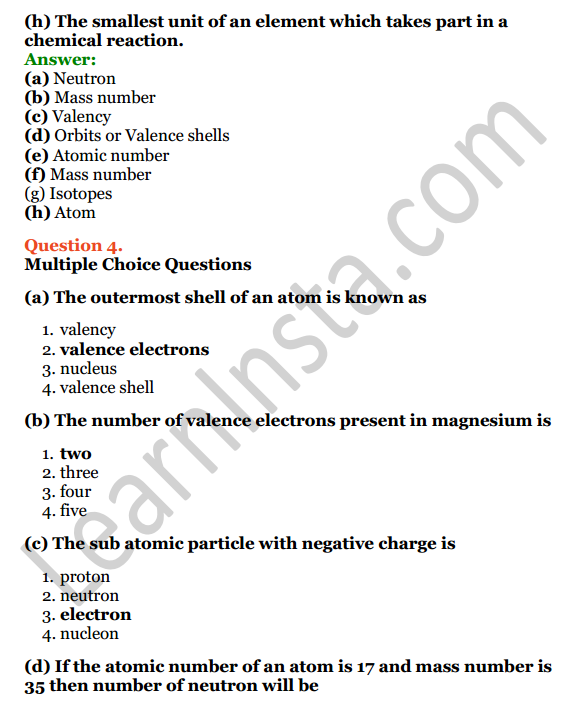
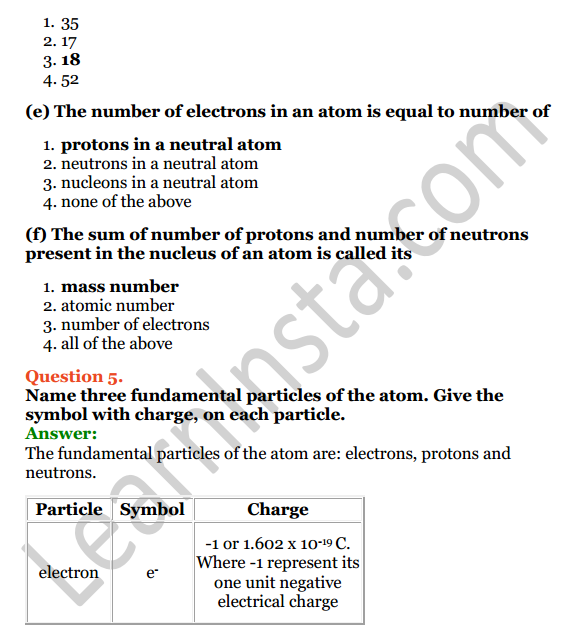

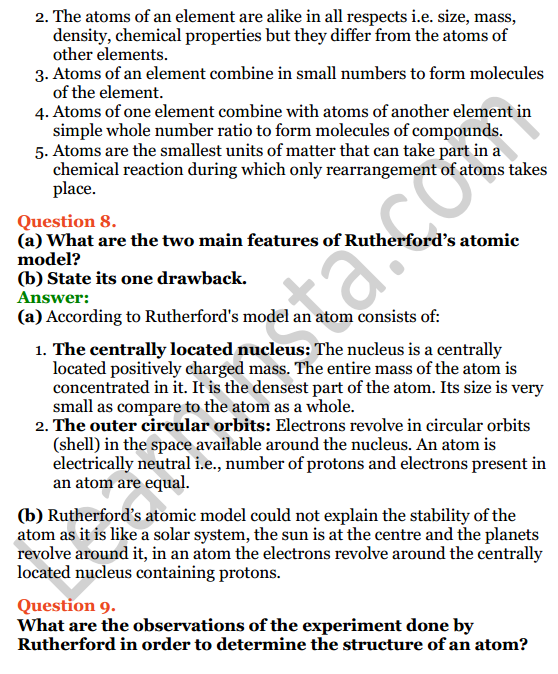
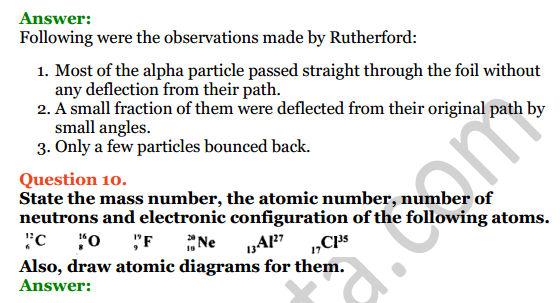
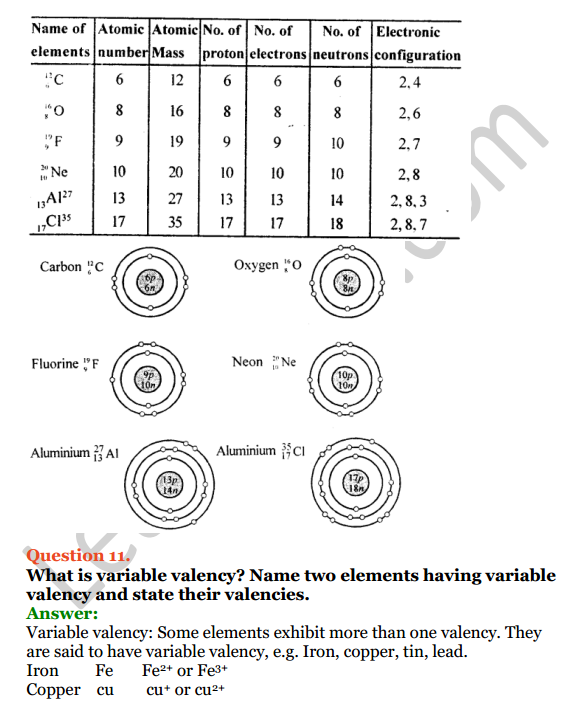

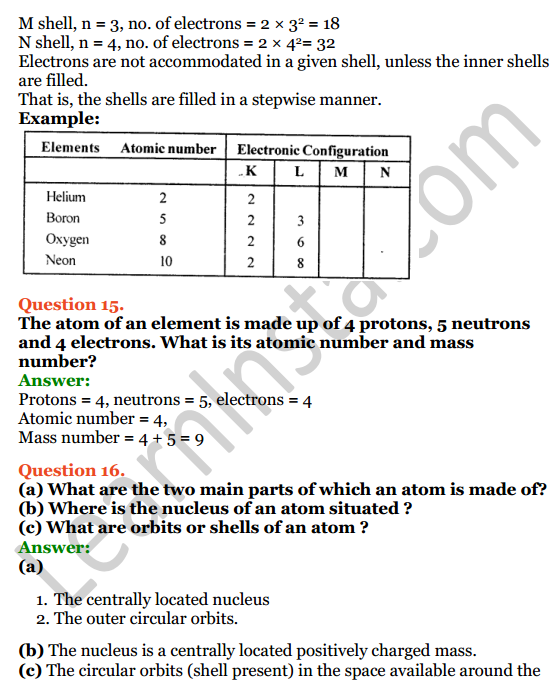
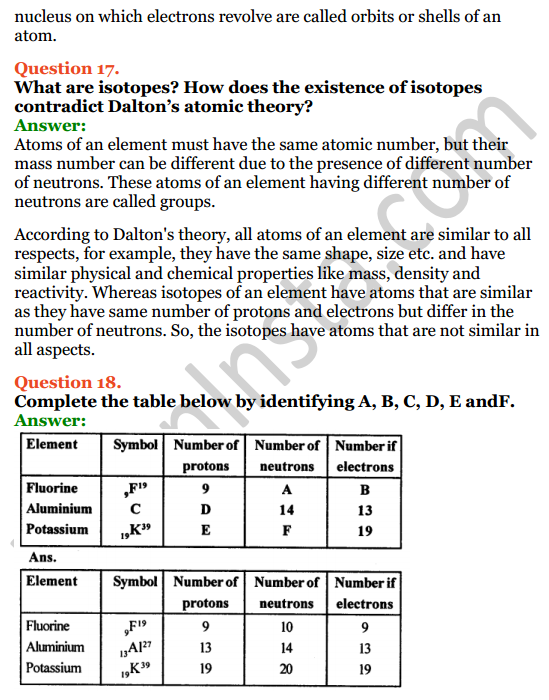
Question 1.
Multiply and express the result in the lowest form:
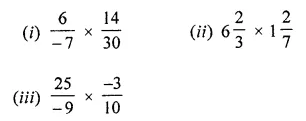
Solution:
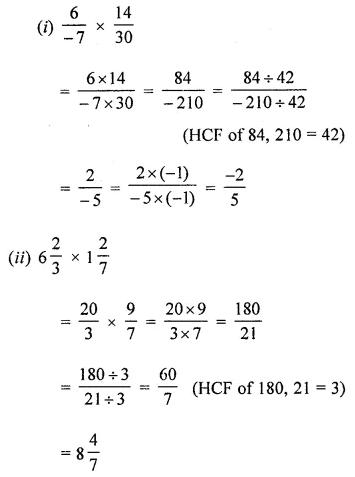
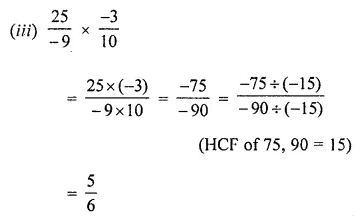
Question 2.
Verify commutative property of multiplication for the following pairs of rational numbers:
(i) \(\frac { 4 }{ 5 }\) and \(\frac { -7 }{ 8 }\)
(ii) 13\(\frac { 1 }{ 3 }\) and 1\(\frac { 1 }{ 8 }\)
(iii) \(\frac { -7 }{ -20 }\) and \(\frac { 5 }{ -14 }\)
Solution:
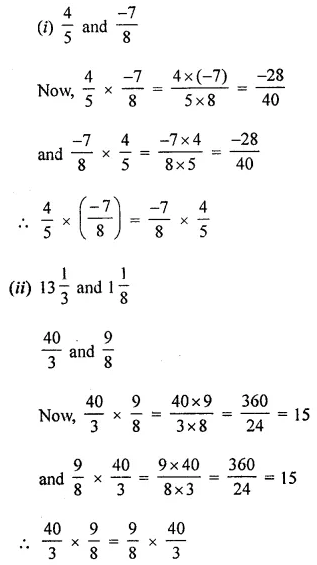
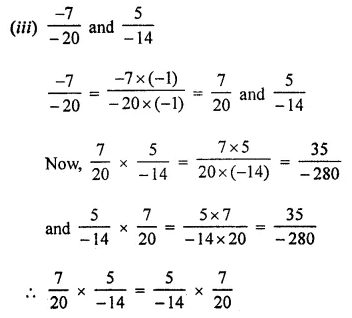
Question 3.
Verify the following and name the property also:
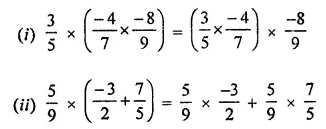
Solution:
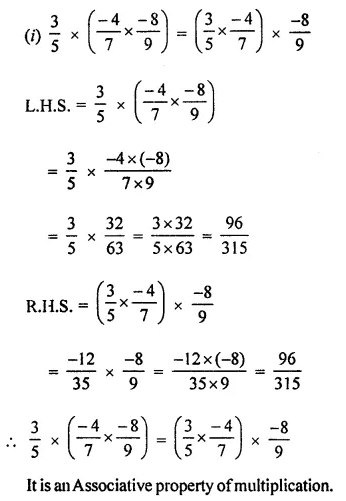
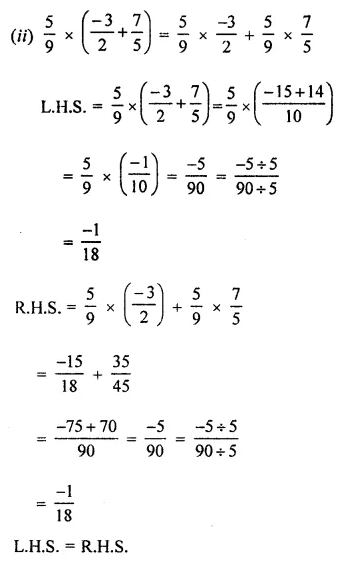
Question 4.
Find the multiplication inverse of the following:
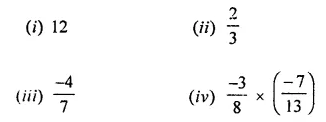
Solution:
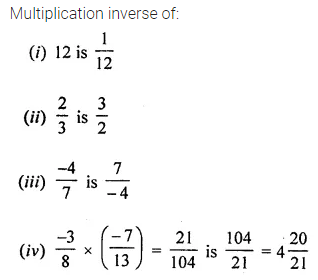
Question 5.
Using the appropriate properties of operations of rational numbers, evaluate the following:
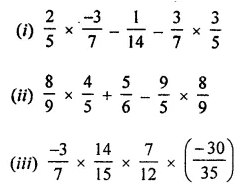
Solution:
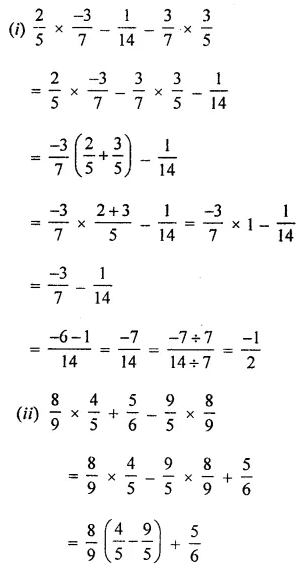
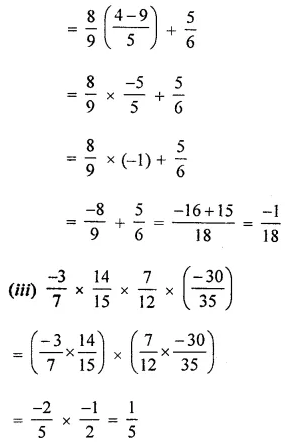
Question 6.
If p = \(\frac { -8 }{ 27 }\), q = \(\frac { 3 }{ 4 }\) and r = \(\frac { -12 }{ 15 }\), then verify that
(i) p × (q × r) = (p × q) × r
(ii) p × (q – r) = p × q – p × r
Solution:
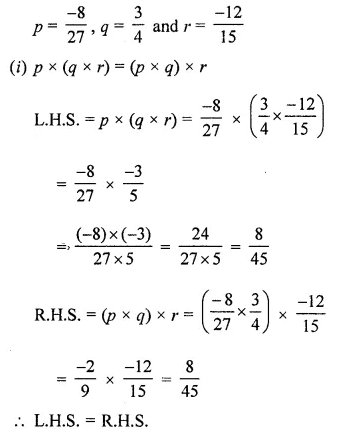
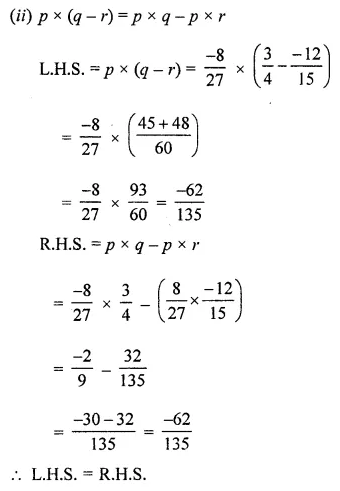
Question 7.
Fill in the following blanks:
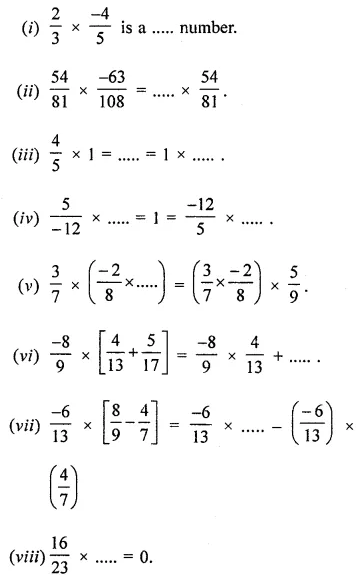
(ix) The reciprocal of 0 is …….
(x) The numbers ……… and ……. are their own reciprocals.
(xi) If y be the reciprocal of x, then the reciprocal of y2 in terms of x will be ………
(xii) The product of a non-zero rational number and its reciprocal is ………
(xiii) The reciprocal of a negative rational number is ………..
Solution:
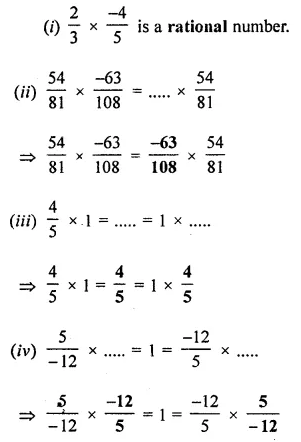

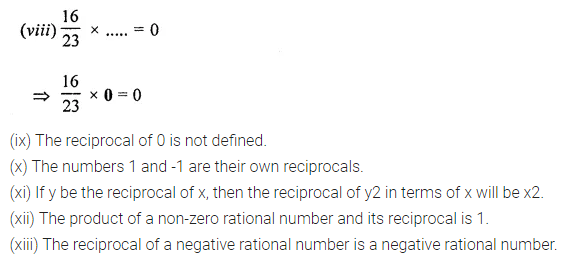
Question 8.
If \(\frac { 4 }{ 5 }\) the multiplicative inverse of -1\(\frac { 1 }{ 4 }\) ? Why or why not?
Solution:
![]()
Question 9.
Using distributivity, find
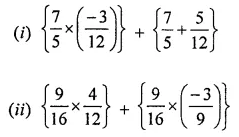
Solution:
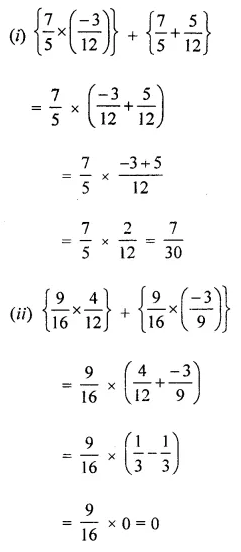
Question 10.
Find the sum of additive inverse and multiplicative inverse of 9.
Solution:
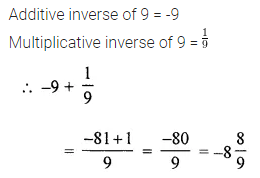
Question 11.
Find the product of additive inverse and multiplicative inverse of \(\frac { -3 }{ 7 }\)
Solution:

Question 1.
Subtract:
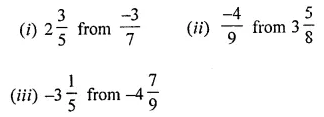
Solution:
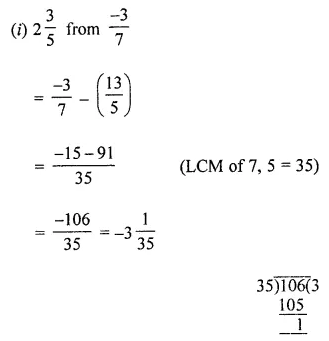
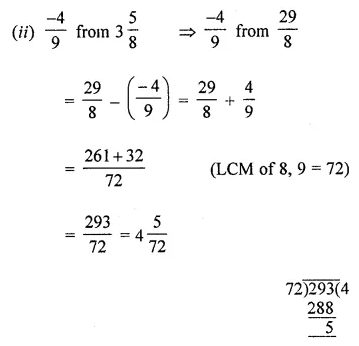
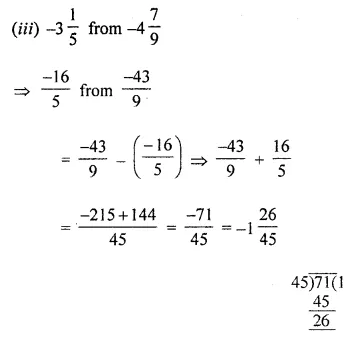
Question 2.
Sum of two rational numbers is \(\frac { 3 }{ 5 }\). If one of them is \(\frac { -2 }{ 7 }\), find the other.
Solution:
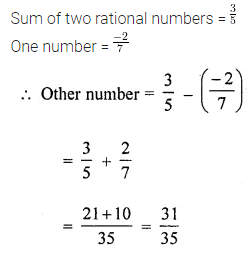
Question 3.
What rational number should be added to \(\frac { -5 }{ 11 }\) to get \(\frac { -7 }{ 8 }\)?
Solution:
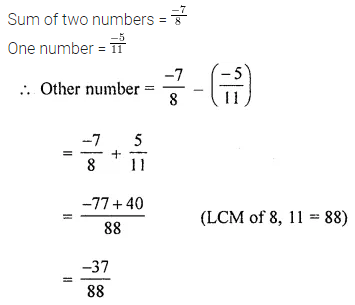
Question 4.
What rational number should be subtracted from -4\(\frac { 3 }{ 5 }\) to get -3\(\frac { 1 }{ 2 }\) ?
Solution:

Question 5.
Subtract the sum of \(\frac { -5 }{ 7 }\) and \(\frac { -8 }{ 3 }\) from the sum of \(\frac { 5 }{ 2 }\) and \(\frac { -11 }{ 12 }\).
Solution:


Question 6.
If x = \(\frac { -4 }{ 7 }\) and y = \(\frac { 2 }{ 5 }\), then verify that x – y ≠ y – x.
Solution:
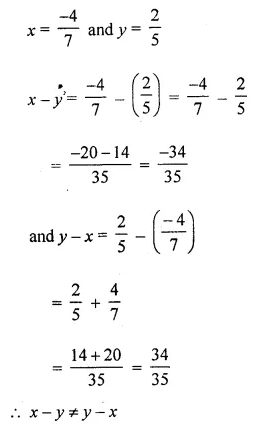
Question 7.
If x = \(\frac { 4 }{ 9 }\), y = \(\frac { -7 }{ 12 }\) and z = \(\frac { -2 }{ 3 }\), then verify that x – (y – z) ≠ (x – y) – z
Solution:
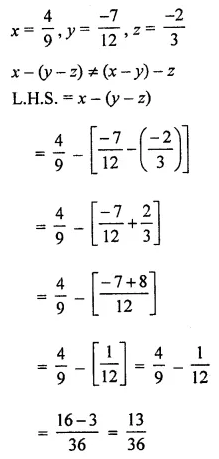
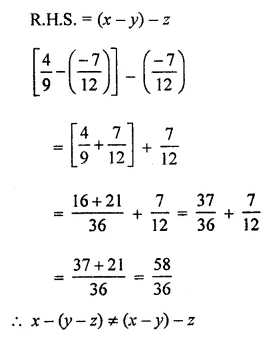
Question 8.
Which of the following statement is true/fasle?
(i) \(\frac { 2 }{ 3 } -\frac { 4 }{ 5 }\) is not a rational number.
(ii) \(\frac { -5 }{ 7 }\) is the additive inverse of \(\frac { 5 }{ 7 }\).
(iii) 0 is the additive inverse of its own.
(iv) Commutative property holds for subtraction of rational numbers.
(v) Associative property does not hold for subtraction of rational numbers.
(vi) 0 is the identity element for subtraction of rational numbers.
Solution:
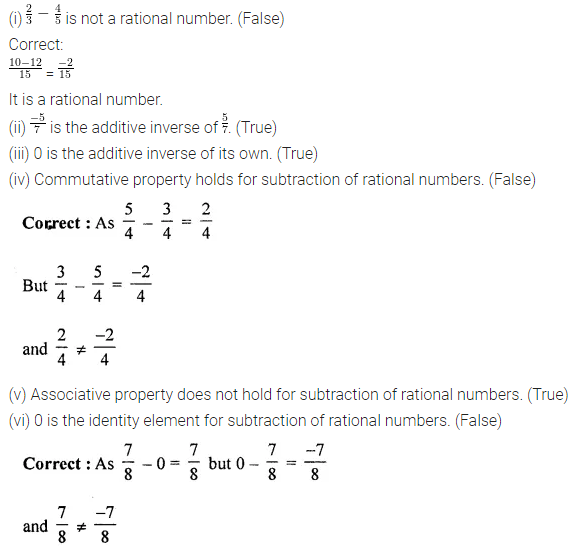
Question 1.
Add the following:

Solution:
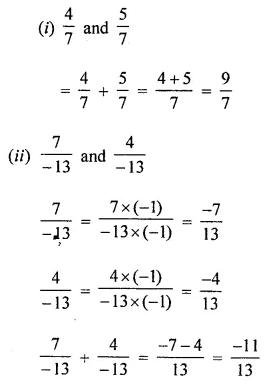
Question 2.
Simplify:

Solution:
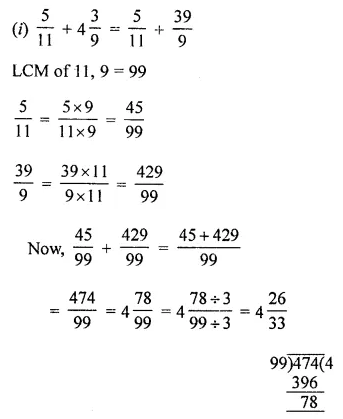
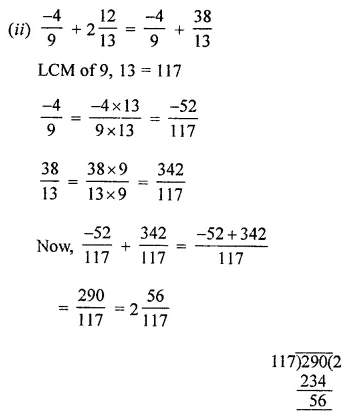
Question 3.
Verify commutative property of addition for the following pairs of rational numbers:
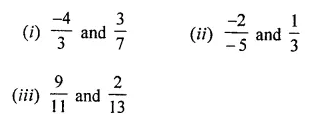
Solution:

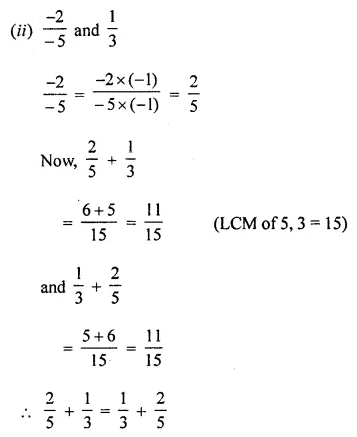
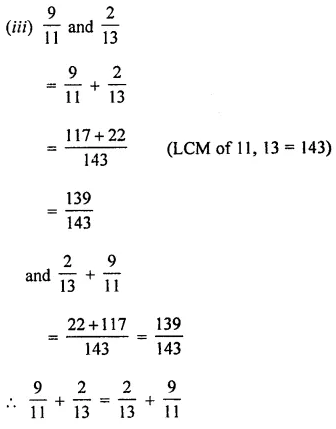
Question 4.
Find the additive inverse of the following rational numbers:
(i) \(\frac { 2 }{ -3 }\)
(ii) \(\frac { -7 }{ -12 }\)
Solution:
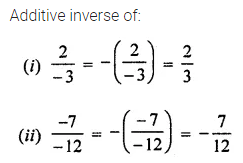
Question 5.
Verify that -(-x) = x for
(i) x = \(\frac { 10 }{ 13 }\)
(ii) x = \(\frac { -15 }{ 17 }\)
Solution:

Question 6.
Using appropriate properties of addition, find the following:
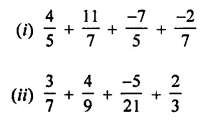
Solution:
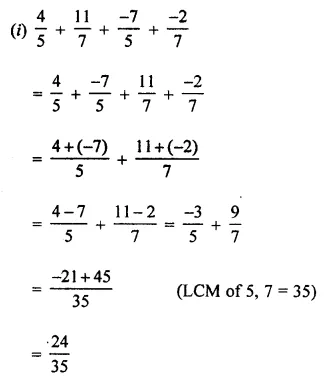
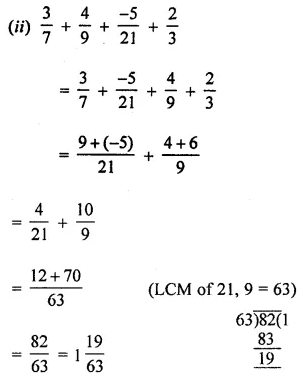
Question 7.
Fill in the following blanks:
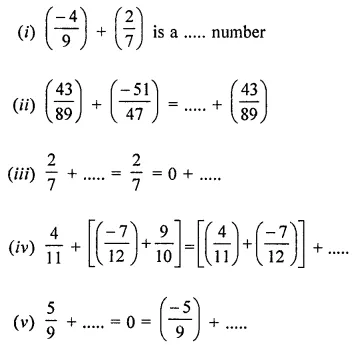
Solution:
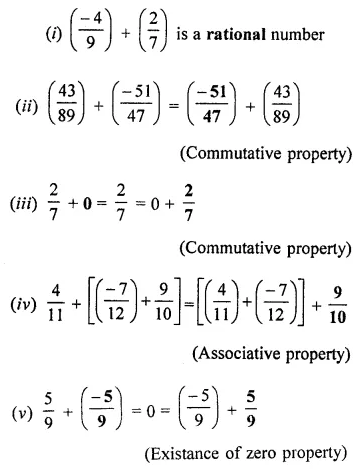
Question 8.
If a = \(\frac { -11 }{ 27 }\), b = \(\frac { 4 }{ 9 }\) and c = \(\frac { -5 }{ 18 }\), then verify that a + (b + c) = (a + b) + c.
Solution:
